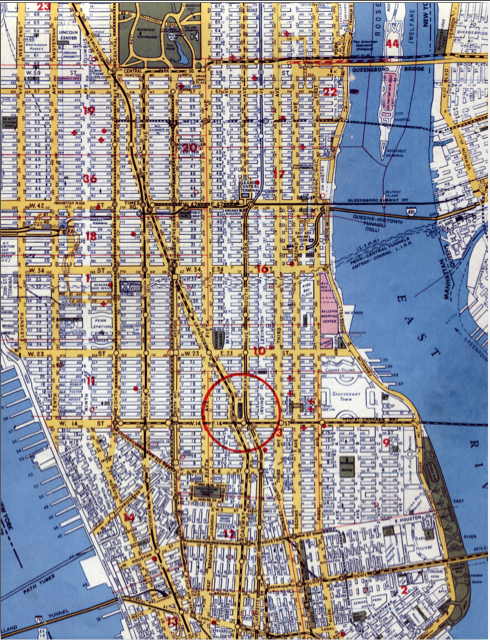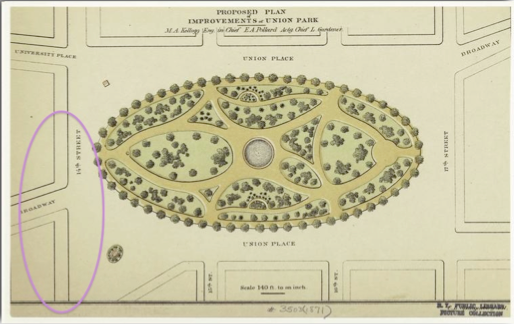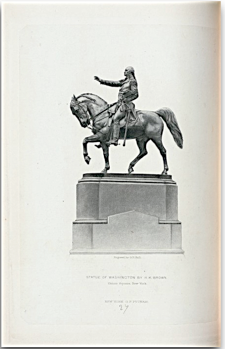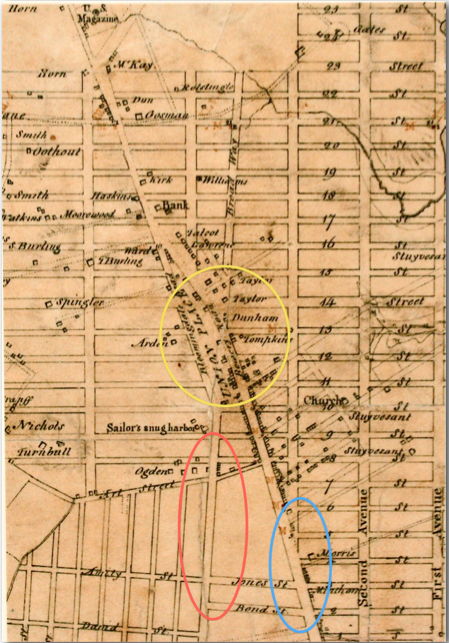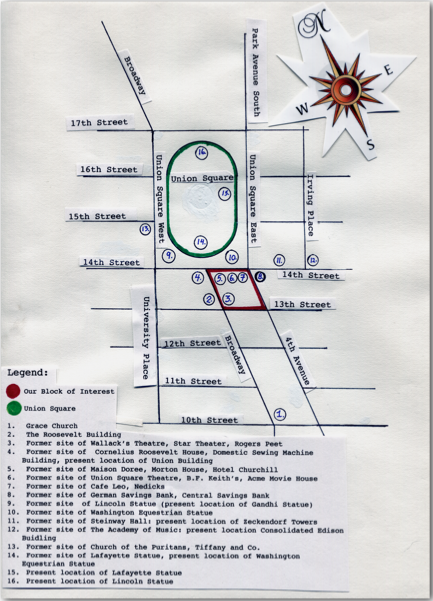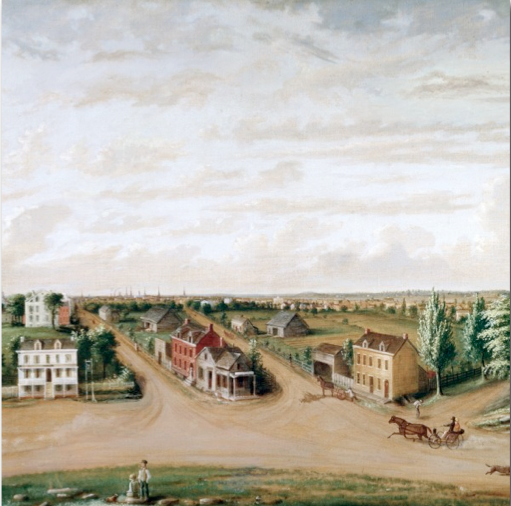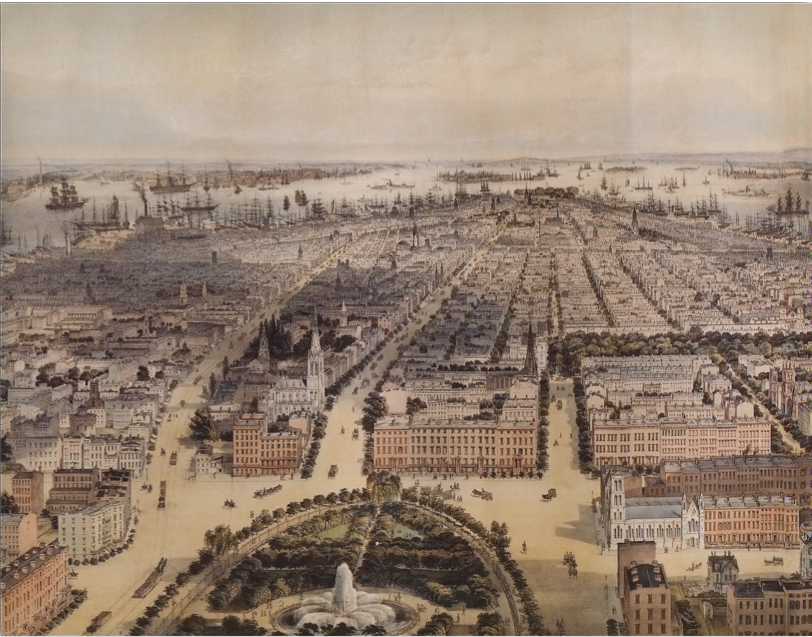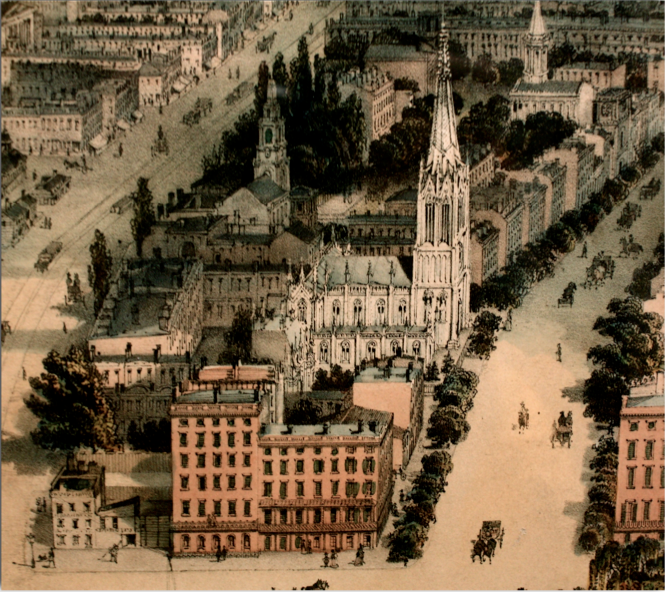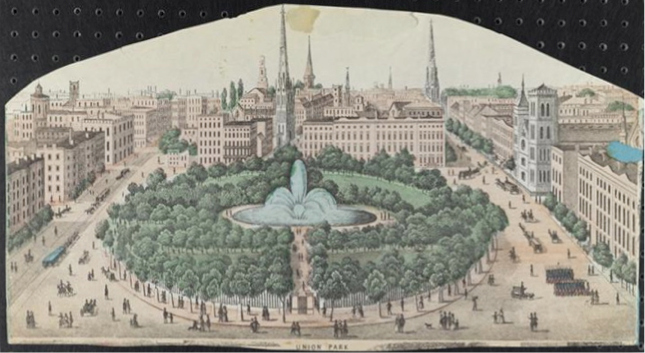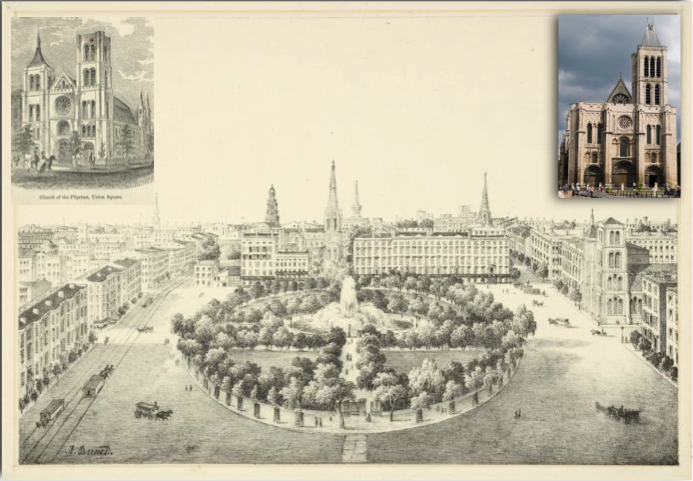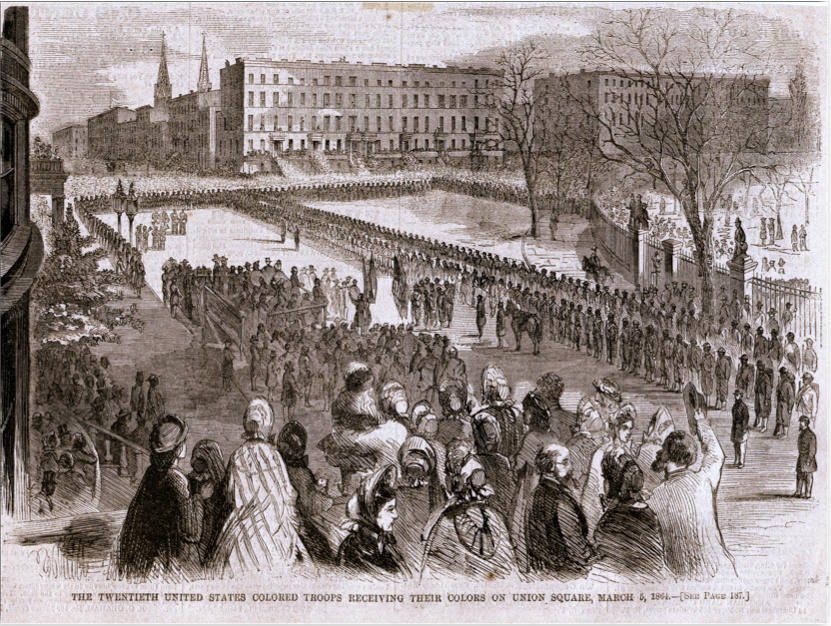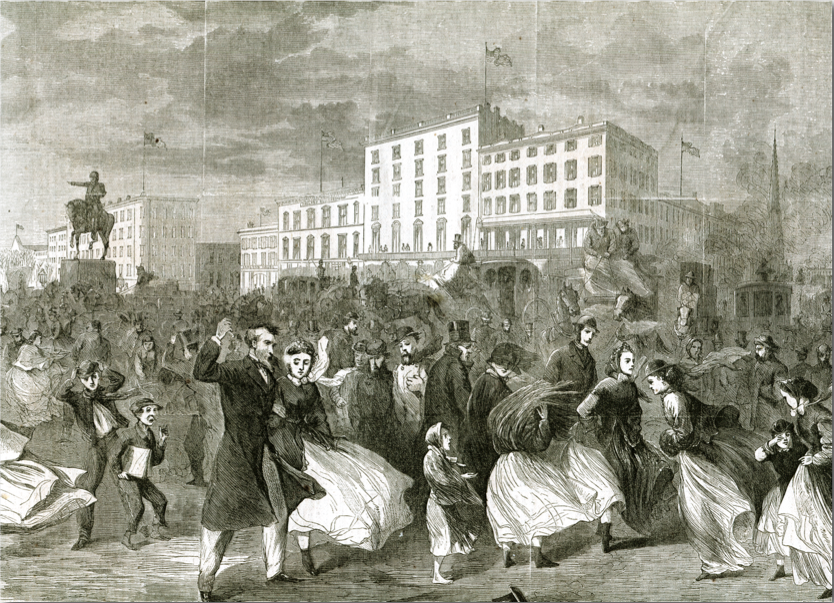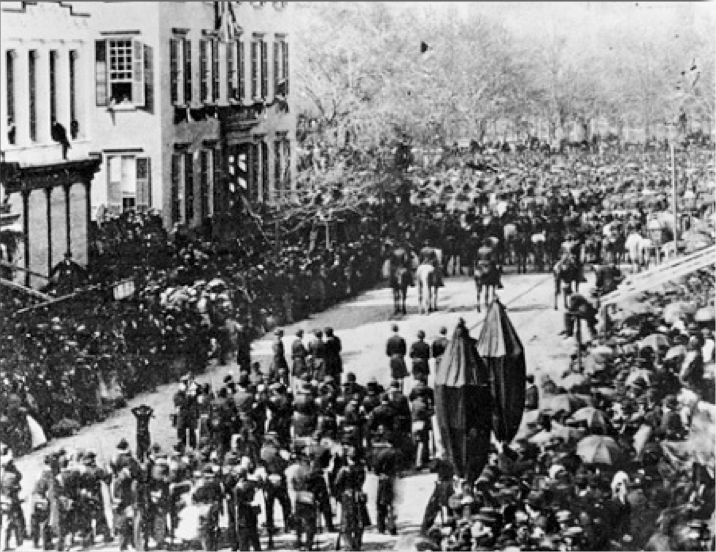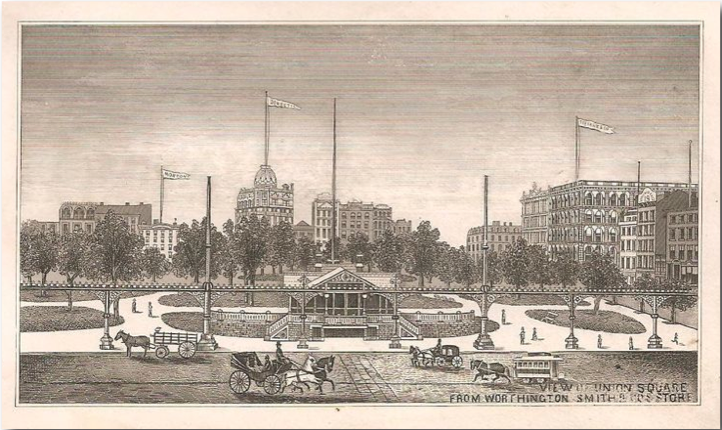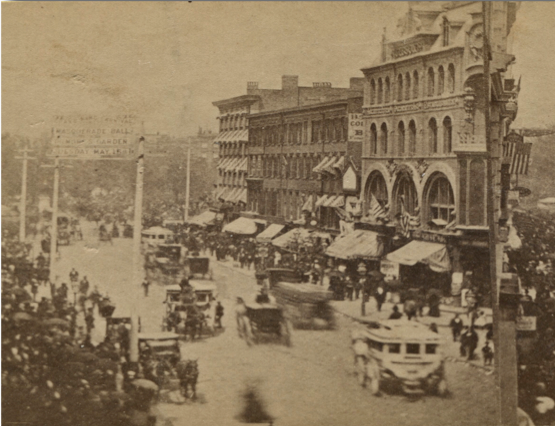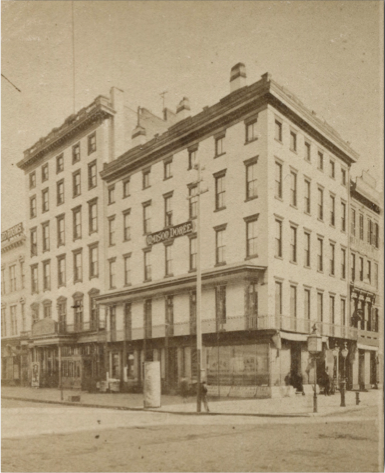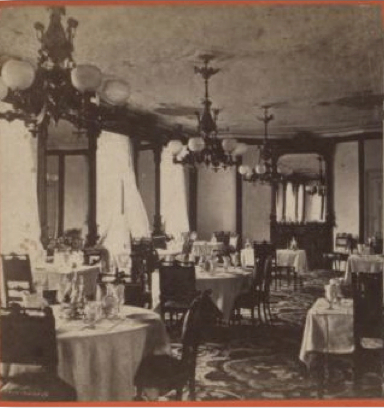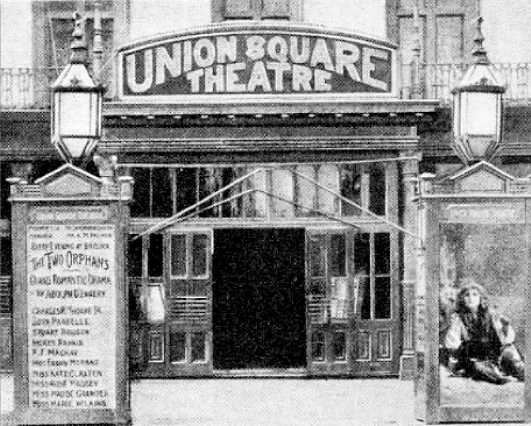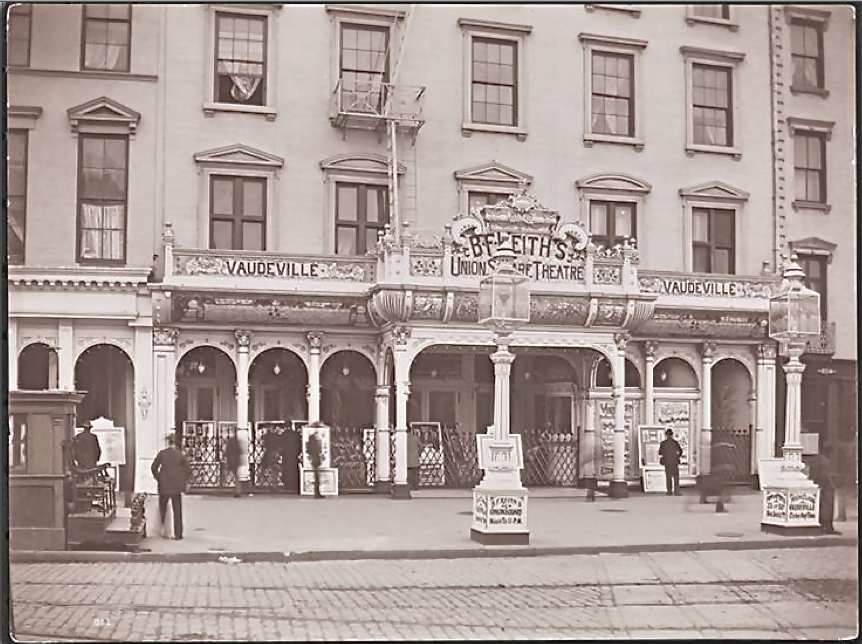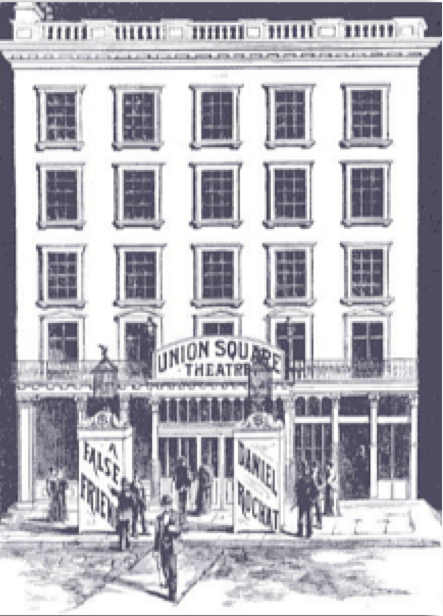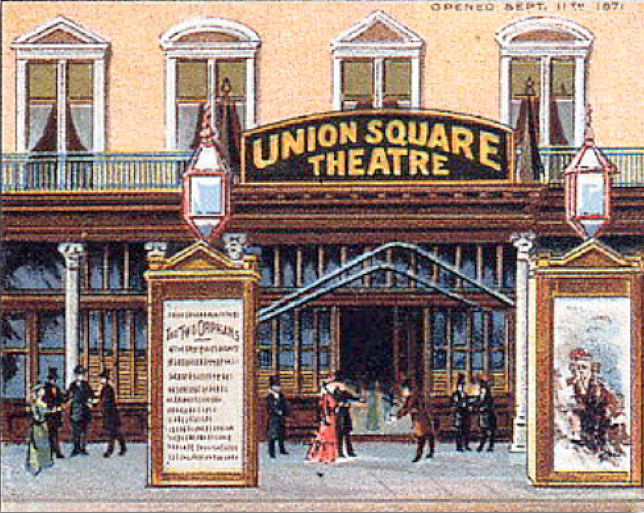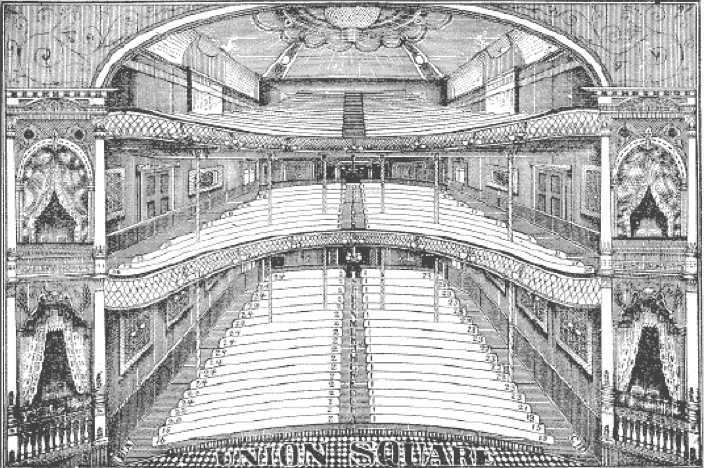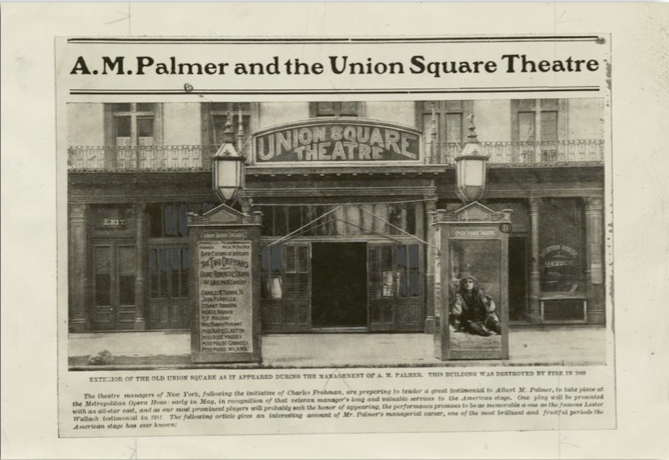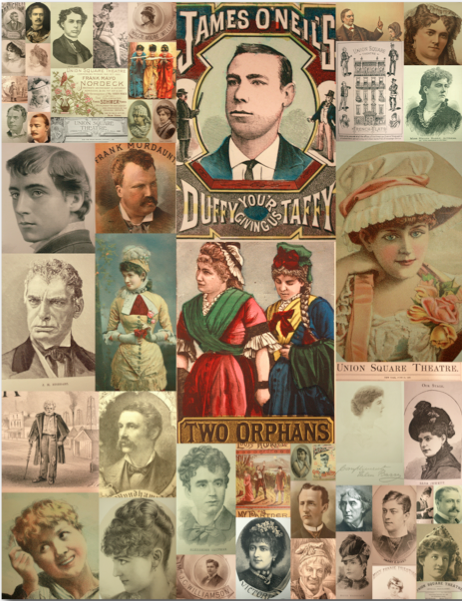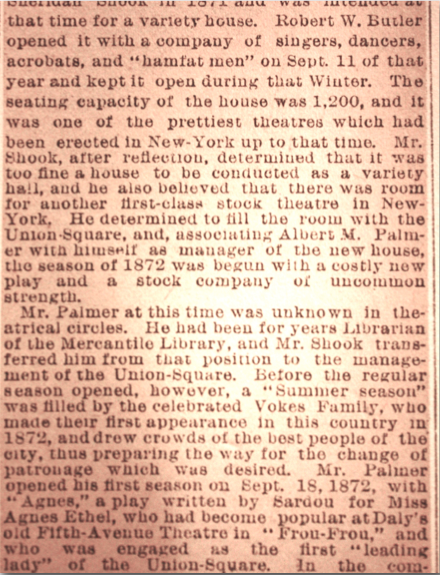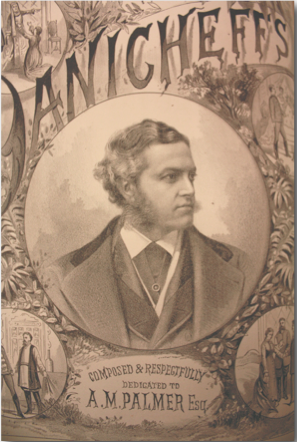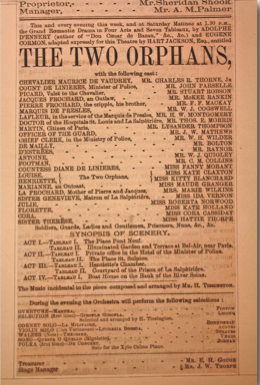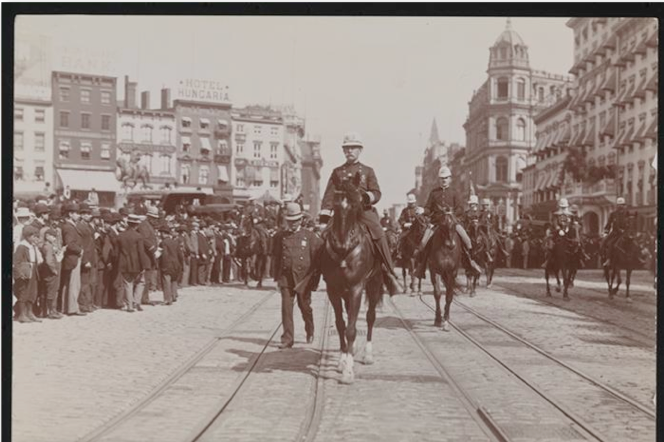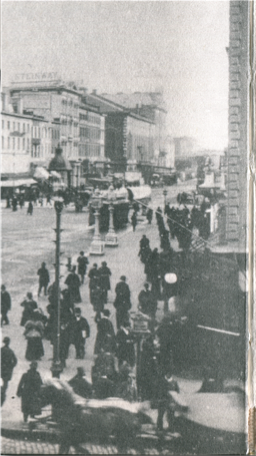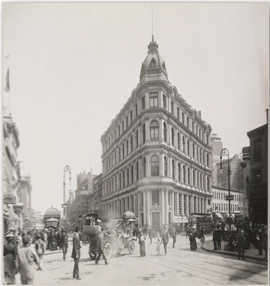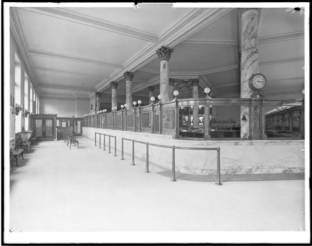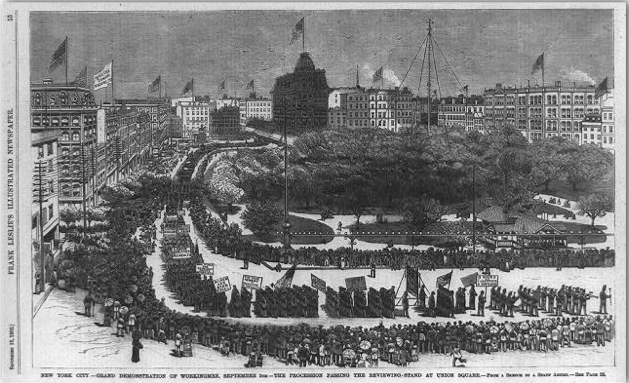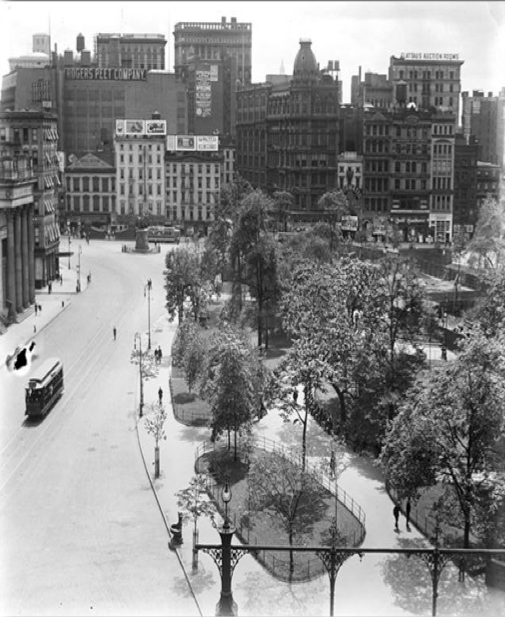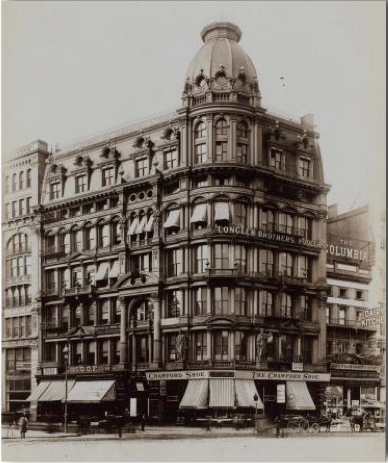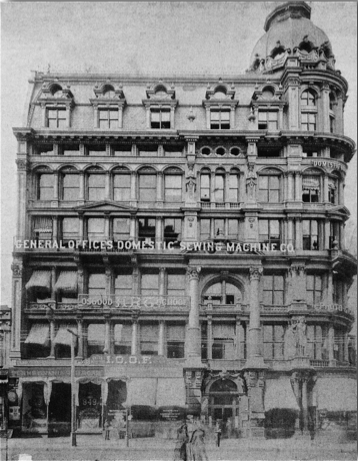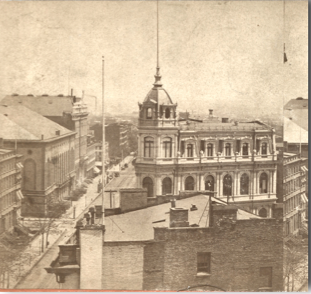GRACE CHURCH AND IT'S REALM:
A Study of the South Side of Union Square
Above is a map showing the southern portion of Manhattan Island, one of 5 Boroughs that comprise New York City. The bit of green at the top of the map shows a portion of Central Park and the tiny dot of green at the center of the red encircled area is Union Square Park which extends from 14th Street to 17th Street and is bounded on the west by Broadway and on the east by 4th Avenue for a total of 3.593 acres.
If you look closely you can see two streets (in yellow) intersecting Union Square at its southern end: the one on the left is Broadway and running parallel and to the right of it is 4th Avenue. Where Broadway makes that little dog-legged turn--four blocks south of Union Square and just where the red circle intersects Broadway, is the location of Grace Church---at Broadway and 10th Street. It was here I grew up, which sparked my interest in this historic district.
This map of Union Square was the joint effort of M.A. Kellogg and E.A. Pollard and was a proposal for a renovation of Union Square in 1871. But a year later Frederick Law Olmsted and Calvert Vaux, their reputation assured by their successful design of NY’s Central Park, took over and removed the fence and hedge, widened the sidewalks and created a reviewing stand “to meet the public requirement of mass-meetings.”
Some say this statue of Washington in Union Square is the finest equestrian statue in the world.
In the map above and on the right (to the north) is 17th Street, and on the left (to the south) is 14th Street. You can note Broadway both on the upper right as it continues northward (uptown) and on the left as Broadway makes its way south to the southern (downtown) tip of Manhattan. The little smidgeon of green to the lower left of the park is where the equestrian statue of Washington was first located (see picture on the right) and the even smaller square on the upper left is where a statue of Lincoln originally stood. Both have been moved from their original locations to prominent places in Union Square Park itself.
A portion of our block of interest is encircled in purple above, but much of our area is not shown on this map.
The map below should provide some further historical perspective.
The famous commissioner’s plan of 1811 (a portion of their map shown above) was downright ruthless when it came to laying out the gridiron plan that Manhattan is famous for today. The plan was no great respecter of natural landscape features, old paths, roads and property lines. But it did preserve three old roads: the Bowery, (later 4th Avenue) encircled in purple; Broadway (in red) and the Bloomingdale Road which really is an extension of Broadway and is on the left hand portion of the yellow encircled Union Place. You can see what a nasty tangled web has been woven with the ‘union’ of these three streets. In 1830 the property owners around the future Union Square (including Samuel Ruggles---more famous for his development of nearby Gramercy Park) successfully asked the Common Council to enlarge the area and in 1831 Union Square was born.
My hand-made map below will, I hope, further clarify the locale in your mind, and to which you might refer as we begin our journey through time.
Hand made map of the south side of Union Square.
South Side of Union Square at Present
It is always surprising to me how this part of New York City seems so often to be neglected, at least when it comes to being photographed, or even mentioned in most guide books. I am always looking for old pictures of the south side (14th Street) of Union Square, between Broadway and Fourth Avenue. But pictures are rare, because nine times out of ten the view of Union Square is looking uptown or northward. To the right, in November 2011 shows how the south side of Union Square (between Broadway, to the right, and Fourth Avenue, to the left) looks today. Sad to say, it has little of its former grander and is today dominated by a mundane building dressed up with fancy artsy frontage, so that perhaps we won’t notice its ordinariness. But an interesting history belies its present banality.
This painting, done in 1885 by Albertis Del Orient Browere, (how is that for a mouthful) purportedly shows what was to become Union Square and the way it looked in 1828. The view is looking south so that would mean 14th Street is parallel to the bottom of the image and that the future Broadway runs from just to the right of center, south west towards the horizon and the dirt lane parallel and to the left of the future Broadway is what was to become Fourth Avenue. Thus the two figures standing foreground left are on the future site of Union Square.
Painting by Browere
Painting by Valentine.
One of the great boons of folks who love old New York is the treasure trove of Valentine Manuals which were published annually in NYC between 1841-1870 (with the exception of 1867). When you go to flea markets or paper shows you usually find them ripped untimely from their tomes, which is how I found this image. I had seen this view in a book somewhere but couldn’t recall where, so I was glad to stumble across this one at a flea market recently.
It is from Valentine’s 1853 edition and shows the ‘Junction of Broadway and the Bowery 1831.’ I’m (educationally) guessing that the large hole in the ground, behind the fellow with the sheep, is the southern portion of the future Union Square. That would make Broadway the road that leads down and to the right of the large gabled house, and the Bowery, later 4th Avenue, the road to the left. Thus we are looking south from about 15th Street.
If you look at the house carefully in the view above, it is not that dissimilar from the house in the view on the previous page. The one immediately above lacks a porch, but don’t forget the picture on the previous page was executed in 1885--many years after this image appeared in 1853.
This is one of those views that is so relentlessly unlike what is there today that part of me says that it could not possibly be an accurate representation. But, just think, New York City was nothing but forest once, so I suppose it’s reliable; trouble is there is so little evidence to confirm or deny its veracity.
Etching by Bachmann
This 1849 etching, by John Bachmann, is the most famous iconic image of Union Square (here known as Union Place Park) and was so called because it was where Broadway (the Bloomingdale Road) and Fourth Avenue (the Bowery) met. In the middle of the Park you can see the fountain that first spouted in 1842 to help celebrate the opening of the Croton Reservoir System. Grace Church can be seen just below center, slightly to the left and our target block can be seen a tad closer to us, immediately beyond the park in the lower left center of the picture. The fact that Bachmann had to imagine this scene (no skyscraper views back then) and that it seems to be so accurate is amazing. (Detail on the next page).
This is a close up of the previous drawing, and clearly shows 14th Street running left to right between Broadway on the right and 4th Avenue on the left. Grace Church can be seen down Broadway between 10th and 11th Street. Behind Grace and to its left is the 9th Street Collegiate Dutch Reformed Church.
In the commissioner’s plan of 1807 ‘Union Place’ was to extend from 10th Street all the way to 17th Street. In 1815 a committee recommended the elimination altogether of ‘Union Place.’ In 1831, by an act of the legislature, the park was to exist from 14th-15th Street between 4th Avenue and the Boomingdale Road. This was found to be unsatisfactory and on April 5, 1832 Union Place reached its present size. The iron fence---seen in many early images--that surrounded the park was installed in 1835 and 1836 and removed in 1871. At the time of this etching (1849) Union Place had become the most fashionable residential area of NYC.
In the detail above the building just to the left of Broadway is the Union Place Hotel and when Sheridan Shook took over the lease in 1871 he called it the Maison Doree, and in 1881 it became the Morton House. (Much more on all of this later). The small, sloped roof structure just to the left (or west) of the six storied rust colored building (later the Union Square Theatre) was the livery stable of Paul D. Burbank. (Hard to imagine a stable on Union Square these days) On the south west corner of 4th Avenue and 14th Street was the upholstery shop of Francis Mercier---the address of which was 156 Fourth Avenue.
Here is another view---Grace Church is just to the left of center. Note our focus just to the left of Grace--facing the square. You can see little balconies on the right most of our group. This drawing a trifle romanticized---no!? It all looks a little too neat and tidy!
Same view. Do you see that stone church at the center and at the extreme right in the largest print on the right? That is James Renwick’s (architect of Grace Church) Church of the Puritans (left inset in the print on the right) which was his knockoff of St Denis outside Paris--(right inset). The Church of the Puritans lasted only 23 years. Tiffany & Co. was built on the site in 1870. Note that the whole area is residential.
This print is captioned the Union Place Hotel. Built in 1850 it would seem to encompass the entire block from Broadway (on the right) to 4th Avenue (on the left). But at this point it was only the building to the right of where the flag is planted. The building to the left of the flag pole was never more than 3 stories tall. See Grace Church squeezed in on the right. That little bit of a pale red- colored building on the right is the Roosevelt house--grandfather of Theodore, the 26th President of the USA.
This old newspaper sketch is from Leslie’s Illustrated---dated March 5, 1864. This must be drawn from about 15th Street and Union Square East--- looking south. That would be 4th Avenue running off to the left; 14th Street running left to right along the top third of the image, and Broadway opening up on the left off of 14th Street---parallel and to the right of 4th Avenue. The steeple on the left (as you head down 4th Avenue) is that of the 9th Street Collegiate Dutch Reformed Church and the spire to the right of that is Grace Church. It is not as clear here as it is in the original, but in the drawing I have you can make out quite clearly the cross-hatching that is characteristic of Grace’s tower. Thus the portico on the extreme left is that of The Union Square Hotel, which certainly had that appearance. The only problem with this drawing is that the southern block of 14th street, between 4th Avenue and Broadway (our block of interest) looks nothing like it does in this drawing as compared to any other drawing or photograph that I have seen. If it were the 1840’s I might believe it--but it is 1864. The artist, I suppose, just made one line of buildings all the same height so he/ she would have less work to do---probably never imagining that 150 years later someone would be questioning their work ethic.
But in spite of inaccuracies I wanted to include it because it purports to portray our block and it evokes the time period well. Also it depicts, in fine detail, the fence around Union Square: rarely seen so clearly.
The drawing above and the one below are real gifts to lovers of old NYC. They were printed by Valentine’s Manual of New York in 1865 and were included in wood engravings showing both sides of Broadway from Beaver Street to Union Square. The image above shows Cornelius Roosevelt’s house on the right (more on him later). Notice the decidedly Dutch influence on the two houses to the left or south of Roosevelt’s home.
The image below depicts the east side of Broadway between 13th Street to the right and 14th Street (or Union Square) to the left. Immediately to the left (or north) of 13th Street is Wallack’s Theatre---back when this part of Broadway and Union Square were to become the center of New York’s theater district. The leftmost building, just south of Union Square housed, in 1865, the Maison Doree restaurant.
This wonderful etching from Harper’s Weekly, dated March 24, 1866, is titled “Union Square, New York, On a Windy Day in March.” Our block of interest is that white row of buildings beginning with the balconied building to the right of center, (south east corner of 14th Street and Broadway) and running leftward. You can see Grace Church down Broadway, on the extreme right, where it appears that the steeple is rising out of a horse pulled public conveyance. What is amazing about this image are the names that are not clear in this digital reproduction, but which in the original are quite legible. The fourth building to the left in our block of interest, the one on the corner (the south west corner of 14th Street and 4th Avenue) which has three stories, has written upon it: “Carlton House,” seen immediately above the first floor. On the building to the right of it, just below the roof cornice, one can make out: “Phelan’s Billiards.” This is the only image that I have ever seen where these buildings are so identified: and I can find nothing written about Carlton House but do recall reading about Phelan’s Billiards, but not sure it was the building depicted here.
What a rare discovery: I’m never kvetching about finding such an etching!
Here is Morton House, on the right---south east corner of Broadway and 14th Street. The caption announces that is is Decoration Day. Notice the statue of Washington which was the first equestrian bronze statue cast in America; the base of which was designed by Richard Upjohn, architect, most famously, of Trinity Church, Wall Street. I have read that it was placed at the exact spot where General Washington met the citizens of New York on the day his troops "liberated" the city from those quarrelsome Brits.
This is looking up Broadway (northward) from 13th Street. Union Square is the center distance.
This is Lincoln’s funeral procession--- Monday, April 25, 1865. The procession has come straight up Broadway from City Hall, right past Grace Church.
The Cornelius Roosevelt house is on the left (the little bit of red in the image on the last page). Some say the two tiny heads looking out of the second floor southern window of the house are a six-year-old Teddy and his younger brother Elliot.
A charming view drawn from the center of Union Square looking south, toward 14th Street. Our block can be clearly seen left of center. Note statue of Washington in its original spot.
An early sketch looking south from 17th Street with all of Union Square before us. You can see the banner of Tiffany and Co. on the building with arched windows on the right. (Replacing the Church of the Puritans) and if you squint you can see the Morton House banner which is the left most one flapping in the breeze. The Domestic Sewing Machine Building is the tallest structure in the middle---also with banner; more on this great building to follow.
This view, is looking north at the east side of Broadway just south or below Union Square. The arched building on the right is Wallack’s Theater (1861-1883). (Much on the famed Wallack’s ahead). Later it became the Star Theater. To the left of Wallack’s and here, sporting awnings, is the south east corner of Broadway and 14th Street.
The banner (very fuzzy) hanging over Broadway announces a Masquerade Ball. From the look of the streetcars, etc. I would guess that this is the 1860‘s.
This is the picture that really piqued my interest on this block, before I really knew anything about it. It was a stereoptic card on eBay--with no information about the location--- but the more I looked at it the more I became convinced that this was indeed the south west corner of Broadway and 14th Street. The name on the front of the place announces “Maison Doree,” which was a restaurant---incorporated into the Union Place Hotel which later became the Morton House. Now if you look closely at the building immediately to the left of the Maison Doree you can see above the entrance way a curved sign upon which was written: ”Union Square Theatre.”
This is an interior view of the Maison Doree. From the fenestration---that’s the window set- up for you non-Francophiles you---it must be 14th Street running along the left side of the picture. Love the gas light fixtures.
The image below is the more common view of the entrance to the Union Square Theatre, which opened in 1871---and was immediately to the left (or east) of the Maison Doree. The date of this photo is 1874 because that is when “The Two Orphans” was produced which is advertised on the left street lamp. It looks so different from its later incarnation as B.F Keith’s Theatre (shown below) which opened in 1893 that I had doubts that the view on the left was the same as Keith’s. The windows hint that we are at the right locale but you can’t see the top of the windows to be certain.
Above is the same building---in the 1890’s when the famous impresario Benjamin Franklin Keith took over the Union Square Theater--beginning in 1893. Can you see how completely different B.F. Keith’s building looks from the original Union Square Theatre?---I am sure you can understand my reservations about whether they were the one and the same.
To add to the confusion, the drawing to the left which clearly announces itself as the Union Square Theatre has only 5 stories, whereas every photograph confirms that it really had six. Also a book on NYC Theaters, by Mary C. Henderson (in her map 4--page 122) places the Union Square Theater on the east side of Union Square.
But notice the pediments over the second floor windows: the left most one is peaked and the one to the right is curved and so on which seems to confirm that B.F. Keith’s and the Union Square Theatre are indeed the same building.
But it was the image below that really clinched it for me.
This card was enclosed in a package of “Between the Acts” cigarettes---and you can see from the window pediments discussed above that this is indeed the building that would become B.F. Keith’s establishment. Keith apparently spent $20,000 on renovations in 1893.
The interior of the Union Square Theater.
The Union Square Theater has a most illustrious history. When it opened in 1871 it was advertised as a ‘temple of amusement’ offering ‘reputable burlesque and vaudeville.’ It had originally been the dining room of the Morton House. The theater was designed by H.M. Simons for the politician Sheridan Shook and was managed by Albert M. Palmer as the Union Square Theatre Stock Co. from 1872 until 1883. During this eleven-year stretch it was the foremost stock company in the city. Here James O’Neill (father of Eugene) starred in “The Two Orphans” (the advertisement of which can be seen in front of the theater in the picture below). This French adaption was the biggest money maker of its time. No less a personage than Henry James saw it and announced that it was “worth seeing.”
Here also the controversial Richard Mansfield, in 1883, played Baron Chevrial in “A Parisian Romance.” A biography tells us that he “had the habit of dining with a young group of Bohemians at a table d’hôte in Sixth Avenue. The means of none of them made regularity at these forty-cent banquets possible, so his absence was meaningless. One evening, however, he dropped into his accustomed chair, but said nothing. “What’s the matter, Mansfield?” asked one of the others. “Tomorrow night, I shall be famous,” he said. “Come see the play.” His prediction proved prophetic---Baron Chevrial made him a star.”
This picture was taken in 1902 when Keith was the manager. Wouldn’t that have been a weird job cycling around a circle made of slats of wood? How was work today, honey?
In 1888 the theater burned and though it was rebuilt it was never again a ‘serious theater.’ Later George M. Cohan made his Manhattan debut in 1893, and even Mae (then May) West performed at this historic venue in 1912. Keith is credited with turning variety theater into vaudeville. On June 26, 1896 it was the site of the first American exhibition of the ‘Lumiere Cinematographe’ the first moving pictures. In 1921 it became the Acme Theater and in 1936 it was broken up and became stores and office space.
I found this view in a scrapbook up at Butler Library at Columbia University. This is looking east down 14th Street. Note that the ‘Morton House’ sign is affixed over three buildings at this point. The German Saving Bank, it’s banner waving aloft, is just east of 4th Avenue and the building beyond it with the triangular topped reddish roof is the second Grace Church Chapel, also known as the Church of the Redemption, which was designed by James Renwick, Jr. It existed for only 11 years---from 1861 until it burned down in 1872.
This image evokes an entirely different zeitgeist than the Union Square of today.
This is a collage of Union Square Theatre stars that I made after photographing the same scrapbook. Prominent is James O’Neill and the poster for the huge hit the “Two Orphans.” There are some images of Helen Barry, but aside from her, all of them are long forgotten except by a few theater cognoscenti. Of course it was an age before TV, film or internet---so maybe the stars of today will live longer in our collective consciousness. But daunting to think how, in relatively short order, all these beautiful people became but mere dust and, even worse-totally forgotten.
Surely that won’t happen to us--will it? Tell me it isn’t so!
More scrapbook paraphernalia about the Union Square Theatre.
The newspaper article above was written after a great fire in 1888 destroyed most of the theater and part of the Morton House. It notes that the theater could seat 1200 and was one of the “prettiest theatres that had been erected in New-York up to that time.”
Above once again is our row of interest on the extreme right. Shot some time after 1893 which is when B. F. Keith changed the facade of the Union Square Theatre (discussed above). Note again the beautiful domed German Savings Bank in the distance on the right. In 1917 it became the Central Savings Bank because during the First World War being German vas nicht so popular!!
To the left, this 1872 view is looking east down 14th Street. Steinway Hall can be seen on the upper left, with the Academy of Music beyond it. On the extreme right is the south east corner of 14th Street and Broadway and mostly, because I know it’s there, I can see the Morton House sign on the corner. I include this picture for two reasons: firstly--- no other image I have seen has that sign mounted on the corner and secondly there looks to be some quoining going on here. (Quoining is that stone work going up the corner of the building). I have not seen that in any other image.
Here, in all its glory, is the German Saving Bank on the south east corner of 14th Street and 4th Avenue. I can remember its gray, looming presence when I was but a lad. Here the famous Augustus Saint-Gaudens had his studio and it is where, in 1913, he met Stanford White. Together they designed the marvelous memorial to Admiral Farragut in Madison Square, among other things, and remained close friends.
A nice shot of the interior of the German Saving Bank.
Another view of the exterior. Note 'Morton House' signage on the right.
While on the subject of interiors, here on the left is a rare view of a dinner held inside The Morton House to celebrate the victory of Bob Fitzsimmons over “Gentleman Jim” Corbett for the World heavy Weight Boxing Championship: March 17, 1897. Corbett had been the Champion, having won the title from John L. Sullivan in 1892. Fitzsimmons’ victory was remarkable because Corbett weighed a full 14 pounds more than Fitzsimmons and out-boxed him for several rounds, knocking him down and badly damaging his face--but Fitzsimmons wouldn’t give up and won the fight in the 14th round when he hit Corbett with his “solar-plexus” punch--- which became legendary. The Corbett-Fitzsimmons fight was filmed by Enoch J. Rector and it was, at the time, the longest film ever released. It premiered, by the way, right near The Morton House at the Academy of Music. With all the banners and flags it’s hard to get a very good idea of the interior of the place, but the only one I have seen.
This engraving is a little smudgy--but the black blob to the left of center is the Domestic Sewing Machine Building--known hereafter as the DSMB: (site of the Cornelius Roosevelt House). The DSMB was put up in 1872. Why the building to the left (part of our focus) looks so dark is a mystery.
This is a wonderfully clear view of our block and you can see the Rogers Peet Building just beyond--more on that building later. My father was a great believer in Rogers Peet--they gave members of the clergy a discount-- and my father, as a man of the cloth, would get his cloths there. I went with him there quite often, and still have an overcoat with their label. DSMB to the right of center.
I just couldn’t resist a couple more pictures of the DSMB--- that’s the Domestic Sewing Machine Building--- for you folks with acronym deficit disorder. It was on the south west corner of 14th Street and Broadway. The image above right shows the Broadway frontage with 14th Street off to the right.
This wonderful structure was the work of Griffith Thomas and when it was built 1872-1873 it was an amazing 110 feet tall and was the city’s highest. Hard to believe!! Very Parisian n’est pas? Many pictures were shot from its roof--see below.
Thomas also designed the Fifth Avenue Hotel---just west of Madison Square (now demolished).
The DSMB is one of New York’s forgotten buildings---I wonder if Teddy Roosevelt appreciated when he recalled his grandfather’s handsome house that once graced this corner.
This is shot from the roof of the DSMB looking east down 14th Street. Our block of interest is right under our noses and we can see the roofs nicely. On the south west corner of 14th Street and 4th Avenue (dead center in this view) is the German Saving Bank. Designed by Henry Fernbach it was built 1870-1872. At first glance one could confuse it with the DSMB. Across the street from the bank you can see a long shed-like building which is the Academy of Music--where the Consolidated Edison building is today. More on this famed establishment below.
